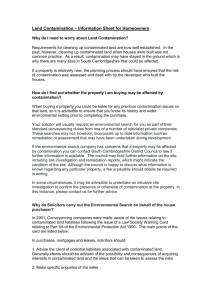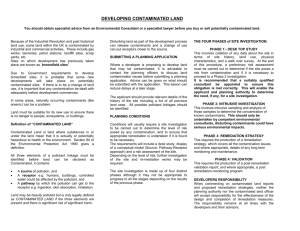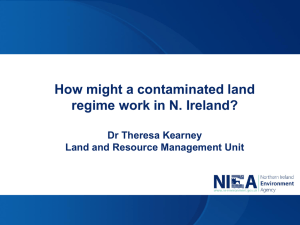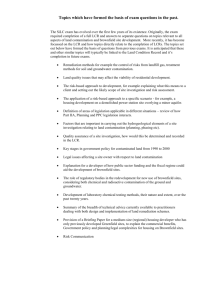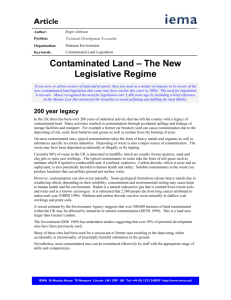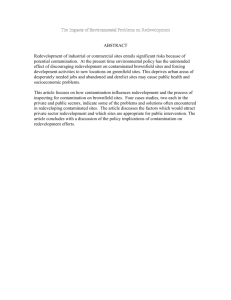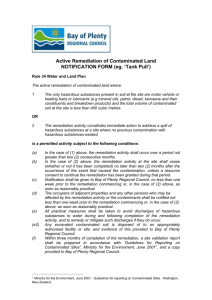4.2 Site Assessment
advertisement
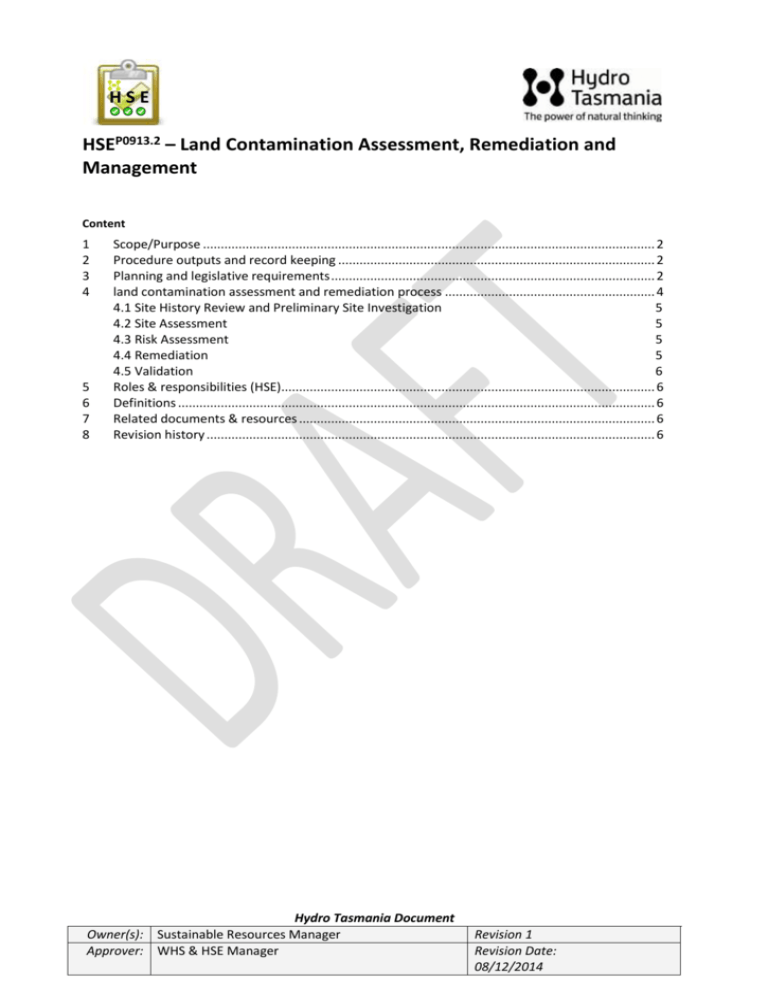
HSE HSEP0913.2 – Land Contamination Assessment, Remediation and Management Content 1 2 3 4 5 6 7 8 Scope/Purpose ............................................................................................................................... 2 Procedure outputs and record keeping ......................................................................................... 2 Planning and legislative requirements ........................................................................................... 2 land contamination assessment and remediation process ........................................................... 4 4.1 Site History Review and Preliminary Site Investigation 5 4.2 Site Assessment 5 4.3 Risk Assessment 5 4.4 Remediation 5 4.5 Validation 6 Roles & responsibilities (HSE)......................................................................................................... 6 Definitions ...................................................................................................................................... 6 Related documents & resources .................................................................................................... 6 Revision history .............................................................................................................................. 6 Hydro Tasmania Document Owner(s): Sustainable Resources Manager Approver: WHS & HSE Manager Revision 1 Revision Date: 08/12/2014 HSE 1 HSEP0913.2 – Land Contamination Assessment and Remediation Process Revision 1 CAUTION: Printed Document is Uncontrolled Print Date: 07/02/2016 SCOPE/PURPOSE The purpose of the Land Contamination Identification, Assessment and Remediation Procedure is to ensure Hydro Tasmania’s activities comply with relevant State and Federal Government legislation and policy relating to contaminated site management. The procedure details specific actions required for undertaking contaminated site assessments and remediating land contamination on Hydro Tasmania properties. The procedure details specific actions required for undertaking contaminated on Hydro Tasmania land sites. In cases where an underground storage tank needs to be decommissioned and removed, the measures outlined on the Tasmanian EPA website should be followed: http://epa.tas.gov.au/regulation/Pages/Underground-Fuel-Tanks.aspx 2 PROCEDURE OUTPUTS AND RECORD KEEPING A summary of the remediation work undertaken is entered into a Contaminated Site Record form and submitted to the Contaminated Sites Database custodian for inclusion in the database. These records are to be kept in the Contaminated sites secure documents location on Sharepoint. Historical records – electronic files and hard copy files for record keeping are kept in secure file on Sharepoint located at Contaminated sites and in the Hydro Tasmania Archives marked as Do Not Destroy, information on location can be found on the data base. Contaminated sites Data Base located at: Contaminated sites will 3 keep up to date records on sites that are still in Hydro Tasmania ownership and current management processes. Links to historical records for sites sold – purchased Contaminated site assessments and management plans for land that is/has to be rehabilitated, sold, purchased or rezoned. PLANNING AND LEGISLATIVE REQUIREMENTS The Tasmanian Environment Protection Authority In Tasmania, the management of contaminated land is shared by the Environment Protection Authority (EPA) and local Council under the Environmental Management and Pollution Control Act 1994 (EMPCA). Where the owner or occupier of an area of land knows, reasonably believes, or should in the circumstances reasonably believe, that the area of land is or is likely to be a contaminated site they must notify the Director of the EPA. If a site poses a known or potential unacceptable risk to human health and/or the environment, or environmental harm is likely to occur, the Director of the EPA may issue a Part 5A Notice (an investigation notice, a remediation notice, a site management notice or an environment protection notice) on a person(s), which can include an individual or company. Other areas of land that contain contaminants in soil and/or groundwater that have been demonstrated not to pose an unacceptable risk of harm to human health or the environment, and therefore are suitable for the current or approved use, are managed by local councils through the land use planning and approvals process. Local Councils The National Environment Protection (Assessment of Site Contamination) Measure 1999 (the NEPM) sets out a framework for assessment of contamination and the risk to human health and the environment, and the methods Page 2 of 6 HSE HSEP0913.2 – Land Contamination Assessment and Remediation Process Revision 1 CAUTION: Printed Document is Uncontrolled Print Date: 07/02/2016 for managing contamination. In Tasmania the NEPM has effect as a State Policy under Section 12A of the State Policies and Projects Act 1993. Principle 5 of the NEPM states that [planning] authorities 'that consent to developments, or changes in land use, should ensure a site that is being considered for development or a change in land use, and that the authorities ought reasonably know if it has a history of use that is indicative of potential contamination, is suitable for its intended use.' The Land Use and Planning and Approvals Act 1993 (LUPAA) requires, under Section 20(1)(B), that planning schemes be prepared in accordance with State Policies. Planning Schemes are therefore to contain specific requirements for the assessment of site suitability in relation to known and potentially contaminated sites. Where a Planning Authority is considering an application in relation to known or potentially contaminated land, the applicant may be required to complete a Contaminated Site Assessment; and/or undertake remediation and/or management measures to demonstrate the site is suitable for its intended use. Contaminated site assessments may be submitted to the EPA Division by a Planning Authority for a 3rd party review under the 'sign-off' process in accordance with Information Bulletin 112 dated February 2011. The National Environment Protection (Assessment of Site Contamination) Measure 1999 (the NEPM) A new site contamination NEPM came into effect on 16 May 2013 by way of variation to the 1999 Site Contamination NEPM. It makes substantial changes to the 1999 Site Contamination NEPM and revises a large number of the definitions and principles which were contained in the 1999 Site Contamination NEPM. More significantly, it substitutes the guidelines which were operative under the 1999 Site Contamination NEPM with a range of new guidelines, including new guidelines on ‘investigation levels’ for soil and groundwater contamination, and on ‘risk-based assessment’ as well as others. The new guidelines concern: investigation levels for soil and groundwater; site characterisation; laboratory analysis of potentially contaminated soils; the methodology for site-specific health risk assessment; ecological risk assessment; the methodology to derive ecological investigation levels in contaminated soils; ecological investigation levels for arsenic, chromium (III), copper, DDT, lead, naphthalene, nickel and zinc; the framework for risk-based assessment of groundwater contamination; the derivation of health investigation levels; community engagement and risk communication; and competencies and acceptance of environmental auditors and related professionals The NEPM can be found at: http://www.comlaw.gov.au/Details/F2013L00768 The NEPM is a large, wordy document. For any questions relating to the NEPM contact Hydro Tasmania Sustainable Resources Management staff. Page 3 of 6 HSE 4 HSEP0913.2 – Land Contamination Assessment and Remediation Process Revision 1 CAUTION: Printed Document is Uncontrolled Print Date: 07/02/2016 LAND CONTAMINATION ASSESSMENT AND REMEDIATION PROCESS Managing Managingaaknow/existing know/existing contaminated contaminatedsite site Undertaking Undertakingaanew newactivity: activity: purchasing, purchasing,sale, sale, divestment, new work, divestment, new work,or or decommissioning decommissioning HT HTbecomes becomesaware awareof of potentially potentiallycontaminated contaminated land land Is the property listed on the HT contaminates sites database? Must Mustnotify notifythe theDirector Director of ofthe theEPA EPA Yes No Potentially contaminated site? Check property history (4.1) IsIsaamanagement managementor or remediation remediationplan planin inplace? place? Yes No Environmental EnvironmentalSite Site Assessment Assessmentundertaken undertaken (4.2 (4.2&&4.3) 4.3) Is the site potentially contaminated? Yes Yes No Consider Considercurrent currentand and proposed proposedland landuse use No Management Managementor or remediation remediationplan plan developed developed(4.4) (4.4) Implement management or remediation plan (4.4) Validation of remediation (4.5) Ongoing management requirements (ie monitoring activities) Continue with new activity: purchasing, sale, divestment, new work, or decommissioning Page 4 of 6 HSE HSEP0913.2 – Land Contamination Assessment and Remediation Process Revision 1 CAUTION: Printed Document is Uncontrolled Print Date: 07/02/2016 4.1 Site History Review and Preliminary Site Investigation The first stage of contaminated site assessment involves establishing a site history of Potentially Contaminating Activities (PCAs). This Site History Review involves the collation of information, from various sources, to determine if the site is, or may have hosted, or is likely to have been impacted by, a potentially contaminating activity. Where a site history review clearly demonstrates that site activities have been noncontaminating this information can be used to justify not progressing with further assessment. However, where there is an indication that the land may potentially be contaminated, as a result of current or past PCAs, a Preliminary Site Investigation (PSI) should be conducted by a suitably qualified and experienced consultant. A PSI usually includes a desktop study to identify the site characteristics (site location, site layout, building construction, geological setting, historical land uses and activities at the site and on adjacent sites) and a site inspection (including interviews with site representatives). The PSI should be sufficient to determine contaminants of concern and identify areas of potential contamination, including all areas of potential contamination sources. The PSI may also include initial sampling to provide a preliminary assessment of site contamination and need for further investigation. Information sources at Hydro Tasmania A starting point for a Site History Review (and a Preliminary Site Investigation) is checking of Hydro Tasmania’s Contaminated sites Database, consideration of the EPA’s Potentially Contaminating Activities List and whether the land in question has hosted or currently hosts, or is adjacent to a site that has hosted or currently hosts a PCA. A Property Information Request from the seller or the EPA may also form part of a Site History Review. The information collected as part of the Preliminary Site Investigation should result in the development of an initial Conceptual Site Model (CSM) - a representation of siterelated information regarding potential or known contamination sources and receptors, and the potential exposure pathways between those sources and receptors. Refer to the EPA’s Site History Reviews and Developing a Conceptual Site Model page or the NEPM Schedule B2 for more information. 4.2 Site Assessment 4.3 Risk Assessment 4.4 Remediation The site assessment should: be undertaken in accordance with the NEPM; and be undertaken by professionals who have the relevant qualifications, competencies and experience for the site contamination issues under investigation. Refer to the EPA’s Engaging a Contaminated Site Assessment Consultant page for further information. A risk assessment is undertaken to establish baseline risks and to determine whether site remediation or other action is required and to determine a tolerable level of contaminants that can remain in place whilst adequately protecting health and ecological values. Site specific response levels are determined for contaminants of concern at the site and compared with laboratory results. If results are lower than the response levels no further action will be required. If results are higher than response levels a Remediation Plan must be developed. Remediation is undertaken as per the Remediation Plan. Hydro Tasmania record keeping A summary of the remediation work undertaken is entered into a Contaminated Site Page 5 of 6 HSE HSEP0913.2 – Land Contamination Assessment and Remediation Process Revision 1 CAUTION: Printed Document is Uncontrolled Print Date: 07/02/2016 4.5 Validation 5 Record form and submitted to the Contaminated Sites Database custodian for inclusion in the database. At the completion of site remediation, validation sampling will be undertaken and compared with the appropriate investigation or response levels to determine remediation success. A Remediation Validation Report is then prepared. Hydro Tasmania record keeping A summary of the validation report is entered into a Contaminated Site Record form and submitted to the Contaminated Sites Database custodian for inclusion in the database. ROLES & RESPONSIBILITIES (HSE) Sustainable Resource Management Team Responsible for maintaining the Contaminated Sites Database and ensuring implementation and ongoing assessment of Management Plans Contaminated Sites Database custodian The database is maintained by either the Senior Field Environmental Advisor or a member of the Sustainable Resources Management Team. Line Managers Responsible for ensuring sufficient budget to manage sites as per designed Management/Remediation Plans. Worker Hydro Tasmania staff involved in property transactions are required to comply with this procedure. All Hydro Tasmania staff are required to report any potential land contamination issues to their manager. 6 DEFINITIONS Accountable person 7 An individual who assumes responsibility for the health and safety of any other person in a workplace and protection of the environment by providing instruction, direction, expert advice or service. All management and supervisory staff are considered ‘accountable persons’. RELATED DOCUMENTS & RESOURCES Risk Assessment HSEP0301 – Hazard Identification and Risk Management 8 REVISION HISTORY Revision Revision number date 0 30.4.14 Detailed revision description New Procedure Reviewed by Beverley Armstrong Approved by Sustainable Resources Manager Page 6 of 6
